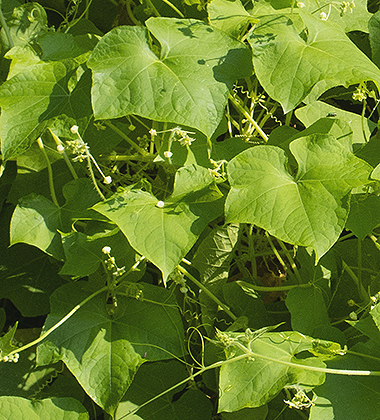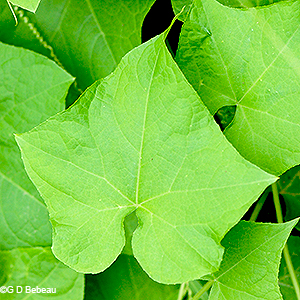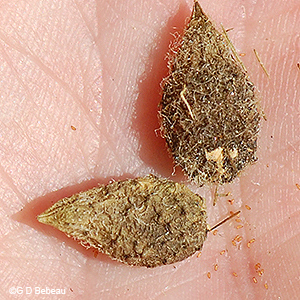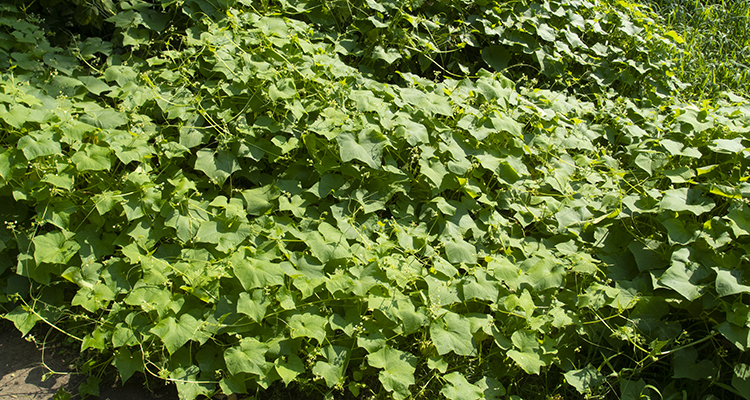The Friends of the Wildflower Garden, Inc.
Plants of the Eloise Butler Wildflower Garden
The oldest public wildflower garden in the United States

Common Name
Bur Cucumber (One-seeded Bur Cucumber, Star Cucumber
Scientific Name
Sicyos angulatus L.
Plant Family
Gourd (Cucurbitaceae)
Garden Location
North Meadow outside back gate
Prime Season
Early Summer to Autumn
Bur Cucumber is a native annual climbing vine with angled hairy branching stems and branching tendrils. Stems climb or trail, sprawling over the landscape and near-by plants. Stems are hairy, usually with glandular hair. Opposite some of the leaf nodes occur either the branching tendrils or the flower clusters. Tendrils branch 3 to 4 times and coil in one direction then reverse direction.
Leaves are broad, almost circular, up to 8 inches long and wide, with 3 to 5 shallow lobes (usually 5), the terminal lobe usually delta shaped; the lower 2 lobes may be quite shallow. A main vein goes to the tip of each lobe and forms a point, except the two basal lobes where the veins diverge. Leaf margins are smooth except for evenly spaced tiny pointed glands. The underside of the leaf has some fine hair, especially on the veins and the upper surface can have short rough hair. Stalks are thick and hairy.
The inflorescence: Bur Cucumber is monoecious, that is with the sexes separated on the plant. Staminate flowers (male) occur in a long stalked raceme cluster of 10 to 21 and pistillate (female) in globose clusters of 8 to 16, usually from the same leaf node, but on a shorter cluster stalk.
Flowers have 5 sepals and 5 petals. The hypanthium is cup shaped. Sepals are very small, mostly delta shaped and partially reflex when the flowers open. Petals are united for part of their length, then somewhat triangular with a glandular hairy upper surface. Staminate flowers have a very small corolla - 4 - 5 mm, white to greenish-white, the green primarily on the veins, with the stamens united in a single column forming a club-like mass at the top and exserted. Pistillate flowers are the same color with 1 style that is obscurely 3 lobed. They are in a close cluster on a short stalk with each flower ovary enclosed in a spiny fruit.
Seed: Flowers mature to a structure in the Gourd family known as a 'pepo' which is a large berry with a tough outer skin. Each flower can produce one pepo but these occur in clusters, radiating outward from a central point, just like the pistillate flowers but usually only 3 to 10 have formed seeds. The cluster often looks star-shaped, hence the alternate common name. The individual pepos are ovoid in shape, containing a single seed, beaked with the remains of the style and with sharp thin needle-like spines on the surface.
Habitat: Bur Cucumber grows from a shallow branching taproot in moist fertile areas where there is not flowing or standing water and especially in disturbed ground. It forms large mats as the photo below shows and regenerates from seed.
Names: The genus Sicyos is the Greek word for cucumber. The species name angulatus means 'angular' and refers to the structure of the seeds and the seed cluster. The author name for the plant classification - 'L.' refers to Carl Linnaeus (1707-1778), Swedish botanist and the developer of the binomial nomenclature of modern taxonomy.
Comparisons: Two plants in our area have leaves and growth characteristics similar to Bur Cucumber. Wild Cucumber Echinocystis lobata, has similar leaves but with deeper sinuses. Its fruit pod is not hard and is four chambered. Canada Moonseed, Menispermum canadense, has a similar leaf but smooth surfaced and the stalk attaches to the underside of leaf and the margin is smooth. The flowers and fruit are entirely different.


Above: Bur Cucumber forms a mat of leaves, stems and tendrils as it climbs over plants and objects. Drawing from Britton, N.L., and A. Brown. 1913. An illustrated flora of the northern United States, Canada and the British Possessions. 3 vols. Charles Scribner's Sons, New York.
Below: 1st photo - a cluster of female flowers with one open. 2nd photo - a cluster of male flowers each with or will have a long hairy stalk compared to the tight cluster of female flowers. Note the reflexed small sepals.


Below: 1st photo - female flowers with the style still exposed. 2nd photo - male flowers.


Below: Two leaves - note the differences in the basal sinuses.


Below: 1st photo - Fine evenly spaced pointed glands line the leaf margin. 2nd photo - stems have angular ridges and a combination of fine and long whitish hairs.


Below: A star-shaped cluster of pepos with their needle-like spines. The individual pepos are the hardened berry-like fruit of the gourd family.


Below: An example of the large mat that the species can form.

Notes: Bur Cucumber has not been recorded within the Eloise Butler Wildflower Garden but is found immediately outside the north side of the Garden in the north meadow. It is not widespread in Minnesota, being known in only 20 counties, most in the southern part of the state including many of the metro area counties. In North America it is found in Ontario and Quebec in Canada and in the U.S. states from North Dakota and Texas eastward. In a reverse of the usual, the species was introduced to Europe as an ornamental and has now become a weedy invasive.
Four species of Sicyos are found in North America, only S. angulatus is found in Minnesota.
Return to -- Site Plan/Archive Index --or-- List of Common Plant Names -- or -- List of Scientific Names -- or --Home Page - - - Back to top.
References: Plant characteristics are generally from sources 1A, 32, W2, W3, W7 & W8 plus others as specifically applied. Distribution principally from W1, W2 and 28C. Planting history generally from 1, 4 & 4a. Other sources by specific reference. See Reference List for details.
 Identification booklet for most of the flowering forbs and small flowering shrubs of the Eloise Butler Wildflower Garden. Details Here.
Identification booklet for most of the flowering forbs and small flowering shrubs of the Eloise Butler Wildflower Garden. Details Here.
©2018
Friends of the Wildflower Garden, Inc. Text and photos are by G. D. Bebeau unless otherwise credited. "www.friendsofeloisebutler.org"
061520